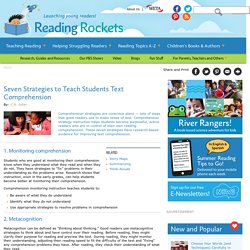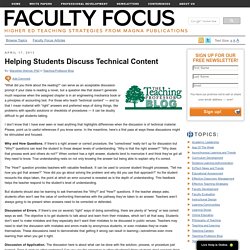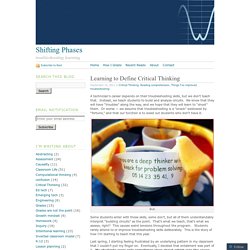

Modeling Comprehension with Think-alouds. Seven Strategies to Teach Students Text Comprehension. 1.

Monitoring comprehension Students who are good at monitoring their comprehension know when they understand what they read and when they do not. They have strategies to "fix" problems in their understanding as the problems arise. Research shows that instruction, even in the early grades, can help students become better at monitoring their comprehension. Comprehension monitoring instruction teaches students to: Be aware of what they do understand Identify what they do not understand Use appropriate strategies to resolve problems in comprehension 2.
Metacognition can be defined as "thinking about thinking. " Students may use several comprehension monitoring strategies: Identify where the difficulty occurs "I don't understand the second paragraph on page 76. " 3. Graphic organizers illustrate concepts and relationships between concepts in a text or using diagrams. Regardless of the label, graphic organizers can help readers focus on concepts and how they are related to other concepts. Www-personal.engin.umd.umich.edu/~brahim/Potential05-reading.pdf. Helping Students Discuss Technical Content. April 17, 2013 By: Maryellen Weimer, PhD in Teaching Professor Blog “What did you think about the reading?”

Can serve as an acceptable discussion prompt if your class is reading a novel, but a question like that doesn’t generate much response when the assigned chapter is in an engineering mechanics book or a principles of accounting text. For those who teach “technical content” — and by that I mean material with “right” answers and preferred ways of doing things, like problems with specific solutions or checklists of procedures — it can be doubly difficult to get students talking.
I don’t know that I have ever seen or read anything that highlights differences when the discussion is of technical material. Why and How Questions. The “How?” But students should also be learning to ask themselves the “Why?” Teaching technical reading. Teaching technical reading I have often taught technical writing, but it never occurred to me that I might need to teach “technical reading” skills as well.

There has been an excellent series of blog posts on Mylène’s blog “shifting phases” on teaching reading comprehension to engineering techs.I particularly liked the techniques in How Reading Comprehension Led To Formal Logic, in which students had a design task (making an assessment plan) that required close reading of rather dry technical material. Having a clear goal for the reading (to minimize the amount of work they would have to do in the assessment, while still meeting the standard) motivated the students to tackle material that they would otherwise have found too difficult and to dry to cope with.
It might be difficult to incorporate some of the methods Mylène uses in my grad classes, but I can see them being very useful in undergrad and high-school classes. Like this: Like Loading... Www-personal.engin.umd.umich.edu/~brahim/Potential05-reading.pdf. Shifting Phases. In January 2011, I overhauled my grading system, and it’s still evolving.

In the old system, I tracked 10 assignments, 15 labs, and 4 tests. In the new system, I still give 10 assignments and 15 labs (roughly). I split each test (which would have been about 1.5 hours long) into three 30 minute quizzes. The difference is that a student no longer gets a grade for the whole quiz. When I correct quizzes, I still mark each question. Why? I do this because each question on the quiz targets a particular skill that I want the student to have. How do you get a grade out of that?
Each course has 4-6 units. If a student completes all the Level 3 skills, they have a score of 3/5 — in other words, 60% (our pass mark). The catch is this: You can *complete* higher level skills anytime; but you can’t get *credit* for them until you’ve finished the previous levels. What Constitutes a Skill? These 10 skills make up the AC Measurement unit. Have I lost my mind? Strangely, this makes much less work for me. Learning to Define Critical Thinking. A technician’s career depends on their troubleshooting skills, but we don’t teach that.

Instead, we teach students to build and analyze circuits. We know that they will have “troubles” along the way, and we hope that they will learn to “shoot” them. Or worse — we assume that troubleshooting is a “knack” bestowed by “fortune,” and that our function is to weed out students who don’t have it. Bull. Some students enter with those skills, some don’t, but all of them understandably interpret “building circuits” as the point. Last spring, I starting feeling frustrated by an underlying pattern in my classroom that I couldn’t put my finger on.
I was only occasionally successful at tapping into their everyday logic. I started teaching technical reading, and boiled down the reading tactics to Choosing a purposeFinding the confusionChecking for mental pictures/descriptionsUsing structural cluesMaking connections to what you already knowAsking questions/make inferences.